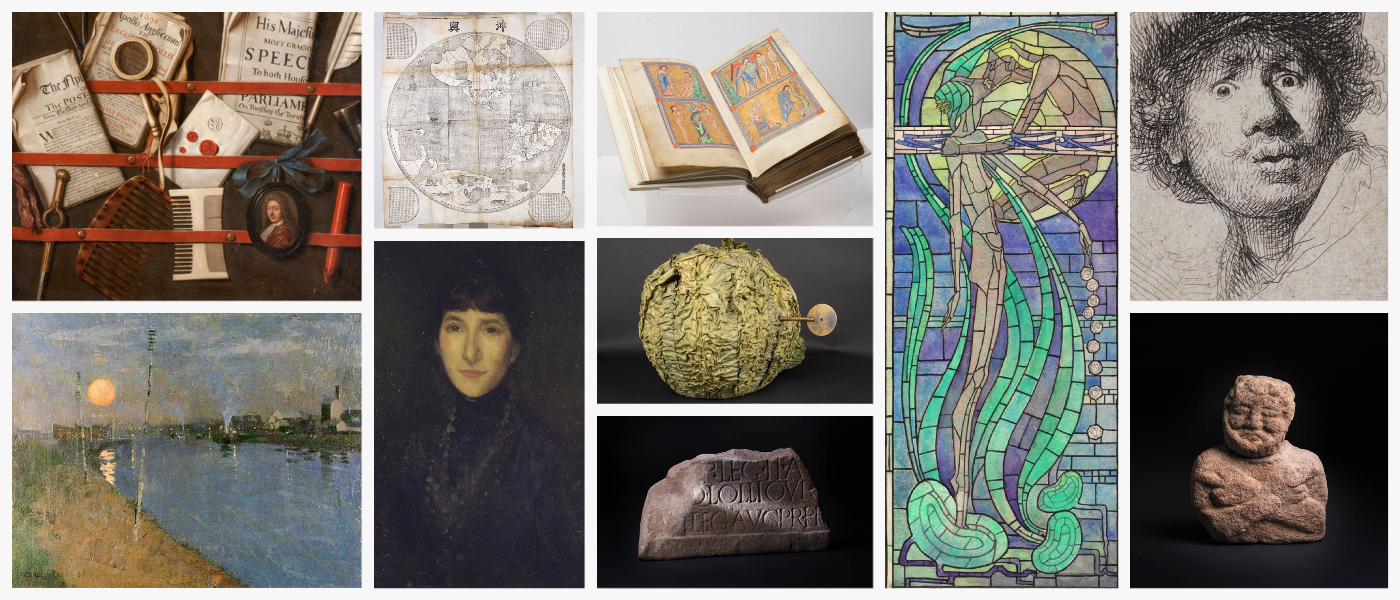
#YourChoice #MyHunterian
The Hunterian is home to one of the largest collections in Scotland. When laid out flat it would cover five Hampden Park sized football pitches – 1.5 million items covering art, archaeology, palaeontology, geology, zoology, entomology, ethnography and numismatics together with University of Glasgow history.
During the early part of lockdown, we asked our followers on Facebook, Twitter and Instagram to choose their favourite objects and artworks from our collections. This virtual exhibition features a selection of those items chosen by you. #YourChoice #MyHunterian
OBJECTS AND ARTWORKS
Summer
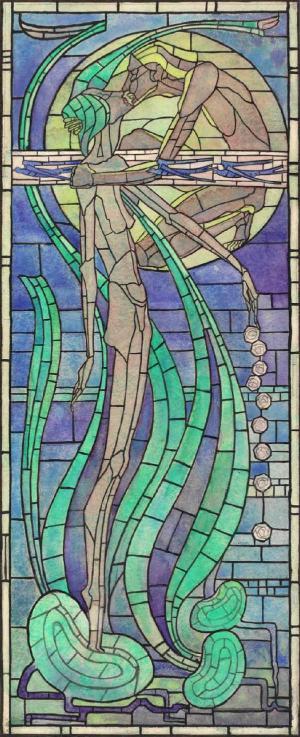 Margaret Macdonald Mackintosh
Margaret Macdonald Mackintosh
Summer
1893-1894
Watercolour, drawing, pen and ink
GLAHA:41047
Margaret Macdonald Mackintosh (1864–1933), painter and designer, was one of the most successful of the artist-designers later called the 'Glasgow Girls'.
During the 1890s, Macdonald produced wide-ranging and innovative work in watercolours, graphics, and metalwork. The designs are characterised by distinctive stylisations of human and plant forms, creating linear, often symmetrical patterns from interlocking limbs, swirling hair and tendrils.
This watercolour design for a stained-glass window from c.1893 is one of the earliest works in which Macdonald shows a highly stylised plant-woman being drawn up out of the earth by a sun-man.
The Hunterian is home to the principal holding of the work of Margaret Macdonald which forms part of its Mackintosh collection - an unrivalled collection of the work of her husband, Scottish artist, architect and designer Charles Rennie Mackintosh (1868–1928). It also features representative examples by her sister Frances Macdonald (1874–1921) and Frances’ husband James Herbert McNair (1868–1955).
Pyrite with cubic crystals
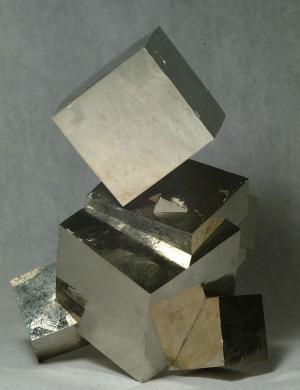 Pyrite with cubic crystals
Pyrite with cubic crystals
Navajun, La Rioja, Spain
GLAHM:M16638
This may look like a piece of abstract sculpture but is actually a specimen of pyrite with large smooth cubic crystals from Navajun, La Rioja in Spain.
The Hunterian is home to over 120,000 rock and mineral specimens as well as around 1,500 cut gemstones and 70 meteorites.
The mineral pyrite, or iron pyrite, is an iron sulfide and is considered the most common form of sulfide minerals. Also known as ‘fool’s gold’, pyrite usually forms very interesting cuboid crystals. The name comes from the Greek meaning ‘stone which strikes fire’ as it sparks when hit with steel.
Pyrite was used as a source of ignition in early firearms in the 16th and 17th centuries but today is used in jewellery, the production of sulfur dioxide for the paper industry and in the manufacture of sulfuric acid.
The Jade Necklace
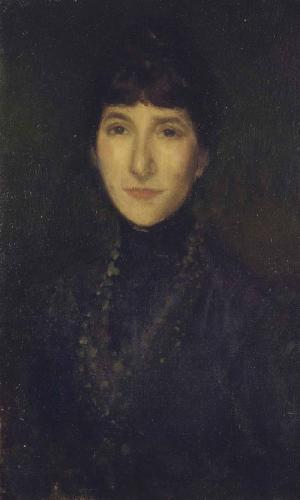 James McNeill Whistler
James McNeill Whistler
The Jade Necklace
1896 - 1900
Painting, oil on canvas
GLAHA:46382
The Hunterian is home to one of the world’s foremost collections of the work of the American-born painter and printmaker James McNeill Whistler (1834–1903), comprising 80 oil paintings, several hundred drawings, watercolours and pastels, over 1,500 impressions of his etchings and lithographs and extensive holdings of his artist’s materials.
After the death of Whistler's wife, Beatrix Whistler, in 1896, the date of this portrait, her youngest sister Rosalind Philip (1873-1958) became Whistler's ward. She devoted herself to Whistler, playing 'Major' to his 'General'. Following his death, she inherited Whistler's extensive estate, which she gifted and bequeathed to the University of Glasgow, establishing the University as the major study collection of Whistler's work.
This portrait of Rosalind was painted in Whistler's Fitzroy Street studio, London, in 1896, but was reworked after exhibition at the Society of Portrait Painters, London. The Indian jade necklace she wears is also in The Hunterian collection. Rosalind was the subject of at least four other oil portraits, as well as a number of drawings and lithographs.
Trilobite
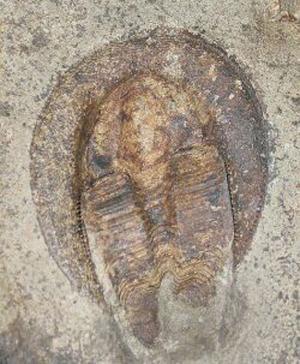 Trilobite
Trilobite
Ordovician epoch
Girvan, Scotland
GLAHM:114854
This trilobite is over 447 million years old and comes from Girvan in South Ayrshire, an area well known as a trilobite hunter’s paradise. It was collected by pioneering geologist George Rae, who spent a lot of time collecting from one particular Ordovician rock exposure called the Lady Burn Starfish Beds.
Trilobites are a group of extinct marine arthropods that first appeared 528 million years ago in the Cambrian period. They lived either on the sea-bed or swam at great depths in the oceans, as predators and scavengers, feeding on plankton or filter feeding.
Trilobites completely disappeared around 250 million years ago during a mass extinction that eliminated over 90% of the species on Earth. Because they have an easily fossilised exoskeleton which moulted several times in a lifetime, an extensive fossil record remains with some 17,000 known species.
There are some 10,000 trilobites in The Hunterian collection with over 6,000 coming from the bequest of George Rae.
Hunterian Psalter
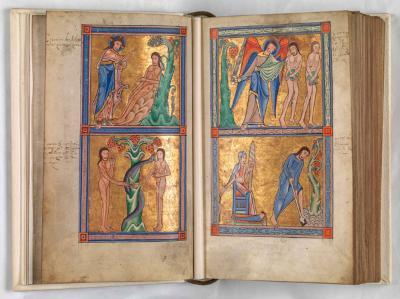 Unknown Author
Unknown Author
Hunterian Psalter
c. 1170
University of Glasgow Library, Archives and Special Collections, MS Hunter 229 (U.3.2)
Hunterian founder William Hunter created an outstanding library of some 10,000 printed books and 650 manuscripts. It contains unique illuminated medieval manuscripts and a significant number of important early printed volumes, including 534 incunabula (books printed in the 15th century).
Regarded as one of the finest 18th-century libraries to remain intact, it is exceptional, both as a working library developed by Hunter to support his professional teaching and research, and as a surviving example of Enlightenment book collecting.
 This volume, known as the Hunterian Psalter is probably the greatest treasure of Hunter’s library. The pages of Latin text are preceded by 13 full-page Romanesque biblical illustrations. Acquired in 1769 from the French library of Jean-Louis Gaignat (1697–1768), the volume cost Hunter 50 livres and 1 sou. At the time, Hunter was generally paying three times as much for early printed books.
This volume, known as the Hunterian Psalter is probably the greatest treasure of Hunter’s library. The pages of Latin text are preceded by 13 full-page Romanesque biblical illustrations. Acquired in 1769 from the French library of Jean-Louis Gaignat (1697–1768), the volume cost Hunter 50 livres and 1 sou. At the time, Hunter was generally paying three times as much for early printed books.
Of international importance, Hunter’s book collection is now in the care of Archives and Special Collections in the University of Glasgow Library.
Musical Box
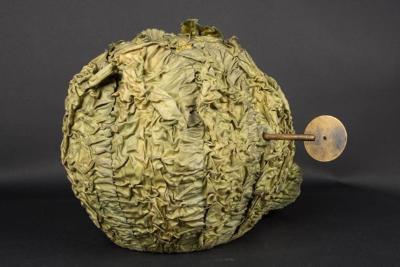 Musical Box
Musical Box
Automaton
c. 1700-1901
GLAHM:C.179
The Hunterian Historical collection is a diverse accumulation of items relating to our history and that of the University of Glasgow. Ranging from pieces of furniture to death masks and Scottish ceramics, the collection also contains numerous miscellaneous objects.
This charming antique musical box or automaton is believed to pre-date 1901. In the shape of a cabbage, it also contains a fur rabbit. The cabbage is constructed from papier-mache with a wooden base and covered in green crinkled fabric which is layered over the top.
 Built to impress and entertain, automata such as this are designed to give the illusion that they are operating under their own power. When the attached key is wound, music plays and the rabbit emerges from the cabbage. Its ears go up and down rhythmically and it appears to chew on a piece of cabbage before going back inside.
Built to impress and entertain, automata such as this are designed to give the illusion that they are operating under their own power. When the attached key is wound, music plays and the rabbit emerges from the cabbage. Its ears go up and down rhythmically and it appears to chew on a piece of cabbage before going back inside.
The rabbit in a cabbage is one of Roullet et Decamp’s signature automata and this one may have been produced by the famous French automaton company.
Images supplied for HISTART5097 Deconstructing the Artefact 2015.
Kunyu Quantu (A Map of the Whole World)
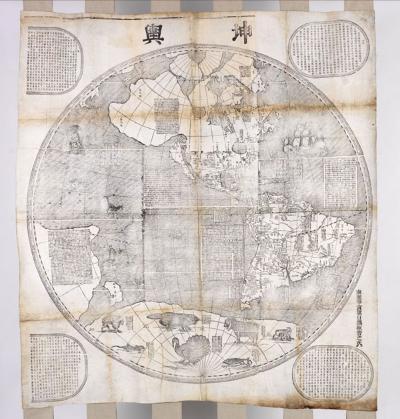 Ferdinand Verbiest
Ferdinand Verbiest
Kunyu Quantu (A Map of the Whole World)
1674
GLAHM:E.289
This historically important map from The Hunterian collection presents a unique summary of global geographic knowledge at the time. It was designed for the Chinese Emperor Kangxi (1662-1722) by the Jesuit missionary Ferdinand Verbiest (1623-88) in 1674.
Verbiest was one of a handful of Jesuits who were employed at the Chinese court and introduced ideas of Western science to China. The map consists of two hemispheres of approximately five feet square.
Cartouches contain information on the size, climate, land-forms, customs and history of various parts of the world as well as details of natural phenomena such as eclipses and earthquakes. Images of ships, real and imaginary animals and sea creatures pepper both hemispheres.
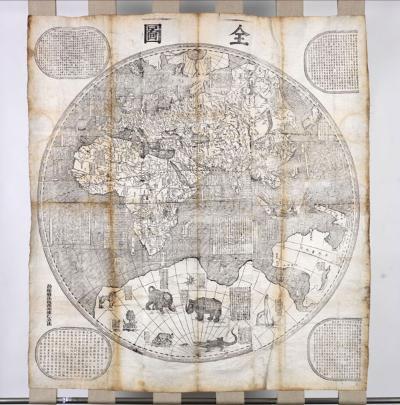 The map is very rare and only one other copy exists in the UK in the British Library (Phillips Collection).
The map is very rare and only one other copy exists in the UK in the British Library (Phillips Collection).
Our copy was in William Hunter's original collection and was one of the earliest known examples to reach Europe.
Bust of Silenus
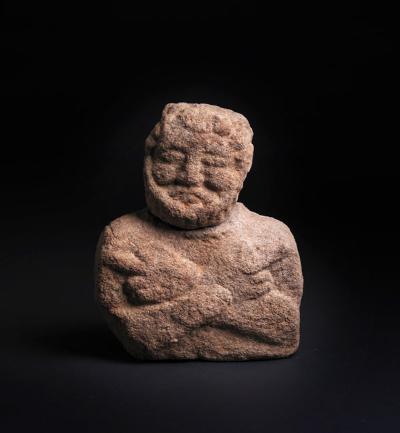 Bust of Silenus
Bust of Silenus
Sandstone
AD 140-170
GLAHM:F.1936.5
The Hunterian Roman archaeology collection is extensive, diverse and of international significance. It contains major holdings of Roman material from the West of Scotland and from the Antonine Wall, ranging from the legionary ‘distance slabs’, unique in the Roman Empire, to everyday domestic artefacts.
This is one of several busts thought to be Silenus, found at Bar Hill Roman fort. Silenus, the drinking companion of the wine god Bacchus, was an older man and usually drunk. He frequently had to be carried around on a donkey. Given these associations, Silenus is a figure of fun whose mischief and exploits appealed to soldiers. His extended fingers are to ward off the evil eye.
All four busts of Silenus recovered from Bar Hill fort are made from local stone All have squared off bases, suggesting they would have sat on pedestals, probably at the entrance to a public building. A possible location would have been the storehouse as this is where the soldiers would get their food and drink.
Trompe l'Oeil, Letter Rack
 Edwaert Collier
Edwaert Collier
Trompe l'Oeil, Letter Rack
1693 - 1710
Painting, oil on canvas
GLAHA:43515
The Hunterian’s collection of Dutch and Flemish paintings includes some exceptional works from the founding bequest of William Hunter including Rembrandt’s Entombment Sketch. In 1963 the collection was greatly strengthened by the gift of 26 works from Ina J Smillie, including this one by Edwaert Collier (1640–1707).
Collier specialised in elaborate 'trompe-l'oeils', still-life paintings which 'trick the eye' by making the viewer think they are looking at real objects rather than painted depictions. He produced works for the Dutch and English markets and spent time working in London. Like this one, his works often feature arrangements of journals, engravings, letters, medals, combs, sealing wax sticks and other ephemera.
Painted c.1700, this depiction of a letter rack filled with personal possessions is thought to pay homage to the celebrated Dutch Admiral Michiel de Ruyter, hero of the Anglo-Dutch Wars. With its numerous symbolic objects, such as the watch, feather and scissors, it also acts as a reminder of the transitory nature of human life. The miniature may be a self-portrait of Collier himself.
Fountainhead
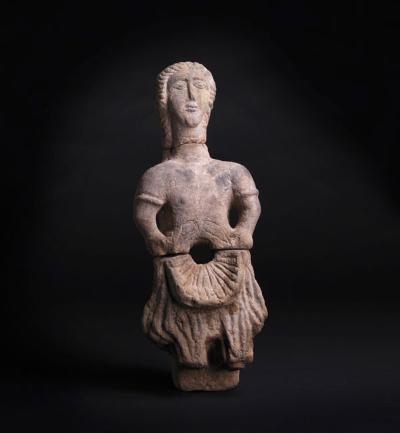 Fountainhead
Fountainhead
Sandstone
AD 142-170
GLAHM:F.44
Communal bathing was a feature of Roman society and the bath-house was where people spent quite a lot of time exercising and catching up on the news. On the very edge of the Empire, the bath-houses of the Roma forts along the Antonine Wall would not have been lavish, but they still would have housed some statuary.
Every Roman fort had a bath-house which usually contained a cold room (the frigidarium), a warm room (the tepidarium) and a hot room (the caldarium).
This statue of a water nymph or fountainhead is from the bath-house hot room at Duntocher Roman fort. It is shaped as a female, naked to the waist, holding a shell in front of her. A metal pipe would have fitted into the hole at the back for water to flow through into a basin. The folds of her skirt may represent flowing waters. She has long hair, is wearing armlets and is Celtic in appearance.
Sundown
 George Henry
George Henry
Sundown
1887
Painting, oil on canvas
GLAHA:43884
George Henry (1858-1943) was one of the Glasgow Boys, an informal alliance of artists that came together in the early 1880s. Determined to develop a distinctive style of naturalist painting, they were keen to challenge the formulaic landscapes and narrative subjects of late Victorian Scottish painting. The Hunterian’s collection of over 200 works by the Glasgow Boys is one of the most important and extensive in a public collection.
By the late 1880s, the Boys were moving towards a more decorative approach, sometimes bordering on the abstract and inspired in part by Whistler’s progressive art.
In this work, previously known as River Landscape by Moonlight, we can see the influence of Whistler’s Nocturne paintings on Henry. Between 1886 and 1888 he painted a number of works inspired by the American's colour harmonies and minimalist approach to detail, finding like him, beauty in a working river.
Henry rarely worked in this manner again, progressing to ambitious symbolist compositions in the early 1890s, and subsequently to more conventional and commercial subjects.
The ‘Jewel of Antiquity’
 The ‘Jewel of Antiquity’
The ‘Jewel of Antiquity’
Sandstone
AD 142-170
GLAHM:F.19
Found at Balmuildy Roman fort, this key object identifies and dates the Antonine Wall. It is the remnant of a Roman commemorative building stone and although fragmentary clearly states that the building it refers to was constructed under Lollius Urbicus who was Governor of Britain from AD 138/9 to AD 143.
Previously people had argued over the identity of the two Roman wall in Britain, the Antonine Wall and Hadrian’s Wall, and 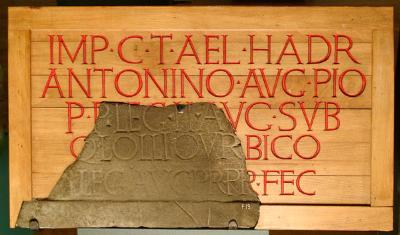 which was which. The discovery of this stone, in or before 1697, recording building work by the Second Legion, established that the wall which ran from the Forth to the Clyde was the Antonine Wall. As a result, the stone was described by contemporary antiquaries as “The most invaluable Jewel of Antiquity that ever was found in the Island of Britain”.
which was which. The discovery of this stone, in or before 1697, recording building work by the Second Legion, established that the wall which ran from the Forth to the Clyde was the Antonine Wall. As a result, the stone was described by contemporary antiquaries as “The most invaluable Jewel of Antiquity that ever was found in the Island of Britain”.
For the Emperor Caesar Titus Aelius Hadrianus Antoninus Augustus Pius, Father of his Country, the Second Augustan Legion under the command of Quintus Lollius Urbicus, the Emperor's legate with praetorian powers, built (this).
Salmon Nets and the Sea
 Joan Eardley
Joan Eardley
Salmon Nets and the Sea
1960
Painting, oil on board
GLAHA:43475
Joan Eardley (1921-1963) was a pre-eminent figure of post-war Scottish art and is best remembered for her paintings of Glasgow children and the Catterline coast. Her priority was capturing the authenticity of her own visual and emotional experiences.
With works on paper, paintings and related archival material, The Hunterian is home to one of the most important groups of objects related to Joan Eardley in the west of Scotland, covering most of her career.
Salmon Nets and the Sea is a striking and characteristic example of the dramatic landscapes she painted in Catterline, a fishing village near Aberdeen. To capture the full drama of Catterline’s tempestuous weather Eardley would set her easel up outdoors in the midst of a storm. Here sand and debris have been incorporated into the paint surface.
To celebrate Eardley’s 100th birthday in 2021, The Hunterian is planning an exhibition of around 20 works highlighting the strength of its Eardley holdings.
Image © Eardley Estate.
Cast of Australopithecus afarensis (‘Lucy’)
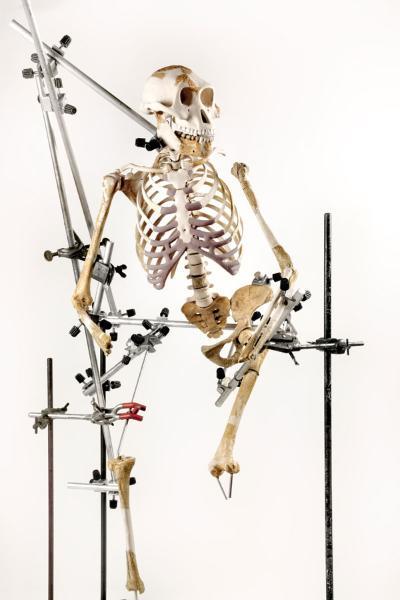 J K Ingham
J K Ingham
Cast of Australopithecus afarensis (‘Lucy’)
Pliocene Epoch
Afar, Ethiopia
The Hunterian is home to a collection of unique fossil hominid reconstructions. This one, affectionately known as ‘Lucy’, not only changed our understanding of human evolution but became a household name.
In 1974, a team of palaeontologists found a three-million-year-old female Australopithecus afarensis skeleton in Ethiopia’s Rift Valley. 40% complete, with some bones badly broken, it was nicknamed ‘Lucy’ after The Beatles song ‘Lucy in the Sky with Diamonds’.
The Hunterian reconstruction is unique as the ribs have been repaired and recast to show how the ribcage would have been in life.
At the time of discovery, the skeleton was the oldest human ancestor fossil ever found. It demonstrated that Lucy had a small skull capacity, like an ape, but also that she walked upright like a human. This supported the view that bipedalism came before the increase in brain size in human evolution.
Self Portrait in a Cap, Open-Mouthed
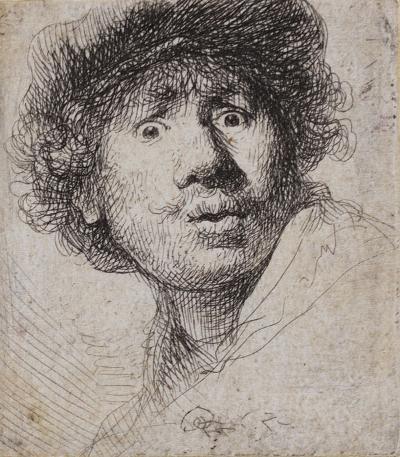 Rembrandt van Rijn
Rembrandt van Rijn
Self Portrait in a Cap, Open-Mouthed
1630
Etching, print, printed in black on antique laid paper
GLAHA:288
Rembrandt van Rijn (1606-1669) is considered one of the greatest Old Master painters. Innovative and prolific, the Dutch painter and printmaker was a master of portraiture and had a unique talent for capturing people in their various dispositions and guises.
Rembrandt made many self-portraits, showing his many moods and changing appearance. These works form a unique visual diary of the artist throughout his career, in which he surveys himself with sincerity and without vanity.
Measuring around 5cm high, this tiny but engaging print from The Hunterian collection is one of the most striking of all Rembrandt's self-portraits. His head studies are most often created with the aim of studying facial expression and light effects. This one powerfully communicates a look of extreme surprise. With eyes wide open and lips pursed, he seems to be recoiling from the viewer.
HUNTERIAN SOCIAL MEDIA

FOLLOW OUR FEEDS
Twitter @hunterian
Facebook @HunterianGlasgow
Instagram hunterianglasgow


